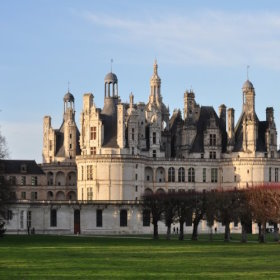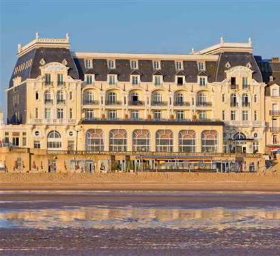Bus tours from Paris to Normandy

Bus tours from Paris to Normandy are day trips. Normandy Beaches, Mont Saint-Michel, Giverny Gardens are the most famous places in Normandy. Normandy combines beautiful seaside landscapes and resorts, old towns and great food. It takes two hours from Paris to Normandy by bus. Our selection of the best Paris to Normandy bus tours. Visit France.
Bus tour from Paris to Normandy beaches
On June 6, 1944, known as D-Day, the Allies opened a new European front against the troops of the Third Reich during the Second World War. It was the largest military operation in history, which marked the beginning of the Battle of Normandy and would lead to the end of the Second World War.
This popular bus tour is an emotional one day tour from Paris to Normandy beaches to relive the D-Day landing and the battle of Normandy. You will see the American Cemetery of Saint Laurent, Omaha Beach, Arromanches and Juno Beach. D-Day Beaches map.

Pointe du Hoc is a famous D-Day beaches sight
Paris to Giverny Normandy bus tour
The village of Giverny is world famous for the house of impressionist painter Claude Monet and its marvellous gardens. Claude Monet settled in Giverny, a lovely village in Normandy near Paris, in 1883 and transformed what was an abandoned domaine into a floral masterpiece, to be the inspiration for many of his greatest works of art. Locate Giverny on France map. A delicious bus tour to Normandy. Not available in winter. Half-day trip.
A day tour combines the visit of Giverny Gardens with shopping at Giverny discount outlet shopping mall.
Giverny Gardens day trips from Paris information and booking

The Japanese bridge ornates Giverny gardens
Claude Monet and Giverny
Claude Monet was born in Paris in 1840. A painter, Monet rejected the traditional approach to landscape painting and learned from nature itself. Monet observed variations of color and light caused by the daily or seasonal changes. Claude Monet settled in Giverny, a lovely village in Normandy near Paris in 1883 and untiringly transformed what was an abandoned domain into a floral masterpiece, to be the inspiration for many of his greatest works.
Claude Monet traveled a lot, but he was never really far from his garden . Through constant correspondence, he kept a close eye on his family and garden. Frequent visits from his friends and admirers turned Giverny into the center of his existence. Until his death in 1926, the great painter would never really leave his Giverny house. Monet in Giverny.
Claude Monet attracted many American painters to Giverny. The interesting Giverny Museum of Impressionisms is a legacy of their stay in Giverny.

Claude Monet lived in Giverny
Mont Saint-Michel bus tour
Discover Mont Saint-Michel, an island off the coast of Normandy, surrounded by a large bay with Europe's most extreme tides, topped by a spectacular 12th century abbey, a UNESCO World Heritage site. Locate Mont Saint-Michel on France map. A unique Normandy bus tour from Paris.
Bus tour Paris to Mont Saint-Michel by luxury air-conditioned coach. Lunch option with view of Mont Saint-Michel. Day trip.
Mont Saint-Michel bus tour from Paris information and booking

Mont Saint-Michel is the Normandy jewel
Two-day trip in France
A unique two-day trip in France from Paris combines Mont Saint-Michel in Normandy and the Loire Castles.
On the fisrt day, discover Mont Saint-Michel, an island off the coast of Normandy, surrounded by a large bay with Europe's most extreme tides, topped by a spectacular 12th century abbey, a UNESCO World Heritage site.
On the second day, discover three of the most beautiful Loire Valley Castles: Langeais, Chenonceaux and Chambord.
Air conditionned bus. Qualified guide. Four star hotel. Two-day trip.

Two-day trip combines Normandy and Loire Castles
Normandy beaches
The most famous beaches in Normandy are D-Day Beaches. They attract many visitors and are lovely beaches in their own right. A great deal of the coast of Normandy has noteworthy seaside resorts. Ahead of Cabourg, Houlgate and Trouville, Deauville oozes style. Glamorous events abound, from prestigious horse races and polo to the annual Deauville American Film Festival. Golf and thalassotherapy abound. Enjoy the elegant hotels, boutiques and restaurants. Normandy beaches facts.

Deauville is a famous beach resort in Normandy
Cabourg Normandy Beach resort hotel
The prestigious 5-star Grand Hotel in Cabourg, where writer Marcel Proust once lived, is located directly on the seafront in Cabourg. It offers stylish guestrooms, some with views of the sea, a gourmet restaurant, a bar and access to a private beach. A Grand Buffet with music is served each morning at Le Grand Hotel Cabourg. The restaurant offers a panoramic view of the sea and serves gourmet regional dishes.
Cabourg 14390 France

The Grand Hotel in Cabourg is on the beach
Mont Saint-Michel pilgrimage
Mont Saint-Michel is a unique pilgrimage place in western Europe. It is dedicated to Michael the Archangel. The position of the sanctuary is also very special. Initially the whole Norman area was covered by woods and sometimes it was invaded by the sea. Three huge rocks of granite and other types of stone detached themselves from the landscape: mount Tombe, mount Tombelaine and mount Dol. The first would become Mont Saint-Michel.
In the Middle Ages, the pilgrimage to Mont Saint-Michel was one of the most important journeys of faith underwent by the medieval man. Due to the difficulty of the road and the position of the sanctuary in the middle of the sea, it became a test of penitence and sacrifice for the medieval pilgrim. The pilgrims to Saint-Michel spread the word of God and the joy of having met the Archangel in the sanctuary beaten by the sea tides. Mont-Saint-Michel facts

The abbey crowns Mont Saint-Michel
Normandy
Normandy is a French region, roughly corresponding to the historical Duchy of Normandy. It covers 30,627 square kilometers (11,825 sq mi) and has a population of 3.37 million. Its inhabitants are called Normans.
The historical region of Normandy comprised today region of Normandy and the Channel Islands. Guernsey and Jersey are British Crown dependencies over which Queen Elizabeth II reigns as Duke of Normandy.
Normandy's name is derived Northmen. Danish and Norwegian Vikings, the Northmen, rampaged the territory in the 9th century and settled there. The treaty of Saint-Clair sur Epte in 911 between King Charles III of France and Earl Rollo gave them Normandy in exchange for peace.
For a century and a half following the Norman conquest of England in 1066, Normandy and England were linked by Norman and Frankish rulers.

Rouen is the capital of Normandy
Normandy England common history
England and Normandy have had strong ties for a long time. William the Conqueror (1028-1087), Duke of Normandy, became the first Normand King of England. After a long struggle to establish his power in Normandy, he launched the Norman conquest of England in 1066. The full story.
When King of England Edward the Confessor died in 1066, leaving no heirs, three rivals disputed the throne : Harold, Harald III of Norway and William, the Duke of Normandy. William claimed that Edward had promised him the throne, and that Harold had pledged loyalty. William assembled a force of 600 ships and 7000 men and set forth with his army in his Viking ships to meet Harold, who had marched south to oppose William. The decisive battle of Hastings, in which Harold was defeated after a day-long struggle, established William and founded the lineage which dominated both sides of the Channel until the thirteenth century.
English troops greatly participated to the D-Day Landing in Normandy on June 6th 1944, which marked the beginning of the decisive battle to free Europe from Nazi domination.

William the Conqueror came from Normandy